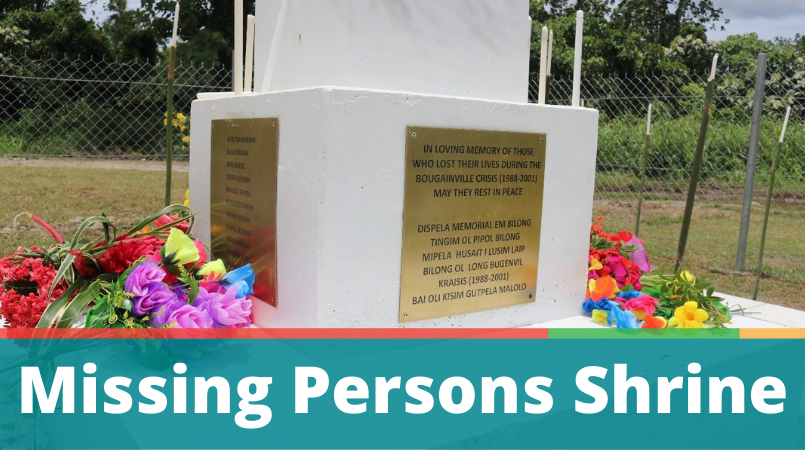
The people of Siwai in South Bougainville recently unveiled a monument, to remember loved ones who went missing during and after the Bougainville Crisis, and remain so.
The families of missing persons often speak of the challenge of living with ‘not knowing’ what has happened, what the future holds or where to turn to for help.
Misconceptions also exist about who went missing and why they are missing. Families report that the community and service providers sometimes misunderstood them. This is traumatic and sometimes goes unresolved.
In recognition of this, the International Committee of the Red Cross (ICRC) and families of those missing in Siwai, South Bougainville, unveiled a monument to commemorate the missing people during the Bougainville Crisis.
Bougainville Civil War, erupted in 1988, when a group of landowners protested against the presence of the Australian owned Bougainville Copper Mine, which at that time operated the Panguna mine.
The war has been described as the largest conflict in Oceania since the end of World War II, with approximately 15,000 to 20,000 Bougainvillians killed. Thousands more are still missing, with no answers for their grieving families.
On March 4th, truckloads of families of the missing arrived at the unveiling of the monument site, some taking short cuts from their villages while others woke up early to make the long walk to attend the ceremony.
The atmosphere was filled with grief and sadness as the families gathered. Many women and children who came to the ceremony were grieving for their husbands, fathers, brothers and uncles.
One young man, who introduced himself as Justin said he was a victim of the crisis. He is missing five members of his family.
“I am Justin Kumpp from Siwai District, Raku village in Bougainville. I am a victim of the Bougainville crisis that created a lot of mess for the people of Bougainville,” he said.
“I have five family members who went missing during the crisis. My father, my mother, my sister, my grandfather and my uncle. I was very young, around the age of nine. I grew up a very traumatized child. I faced a lot of problems growing up. I couldn’t get a proper education because my parents were taken away.
“Therefore, when I heard about this event and saw the monument, I was happy. I am still healing in the process, but I am hoping in future, coming to pay tribute at this monument will give me the peace that I am longing for,” Justin said.
Another survivor, Margaret Sohun from Konga in the Kopi Constituency of the Siwai District, was a guest speaker at the event.
“The very reason why I am here for the unveiling of the monument is because of my brother Joe,” she said.
Her brother Joe was taken away in 1992 during the crisis and he never returned.
“There was a raid in my village, my brother was shot in the arm and escaped to the bushes. When he realized the villages were raided too, he came out and surrendered. He told the forces attacking us to take him and leave the villagers alone. Sometime later, we heard he was killed. To date, we have not located or have any idea of (his remains),” Margaret explained with tears.
She said further, “Joe was the third born in our family, right after me. I was Joe’s favorite sister. We had a very happy childhood growing up together until that day he was taken away. In times of need, my brother was very helpful to our family. He was an accountant by profession, so he would assist us financially.”
Margaret continued to share that now, with the monument bearing the names of the missing persons, it would make it easier for families to visit and pay their respects to their lost loved ones.
“We will also feel closer to them because the monument is there, with their names clearly engraved. All our pain in our hearts will finish now, with this monument standing here,” She said.
She thanked the ICRC, and other responsible authorities and the local community who played a part in the preparation and construction of the monument and making it possible for them to have a place to grieve.
Catherine Anugu, from Oso village in the Siwai District, is a teacher by profession and mother of nine. She also attended the monument’s unveiling. She was heartbroken.
“My heart is terribly broken for my husband because I didn’t see him when he was killed. Myself and my nine children have been left with great suffering after the loss of my husband,” she said.
She said, “Despite our loss, I found the courage to raise my children and give them a proper education. My children have all grown up and are now able to take good care of me. I am happy and dealing with the loss of my husband but today, when I came and saw everyone gathered in front of the monument, it reminded me of my missing husband, and I cried out loud.”
Catherine said she had found peace through the monument.
ICRC Head of Office in Bougainville, Mukhamed Khavtsukov, said the ICRC has been working closely with local communities seeking to support the families of missing persons who are still searching for answers.
“The hostilities apart from the physical damage they have, the psychological trauma is sometimes a lasting effect which can be lot more devastating than the physical loss,” he said.
He added that the ICRC tries to work closely with the families and try to provide them with support so that eventually they would find comfort and closure.
The ICRC maintains close dialogue with communities, central authorities in the Autonomous Region of Bougainville (AROB), working at district levels and community levels, and with the families directly to try to better understand their needs before delivering support.
